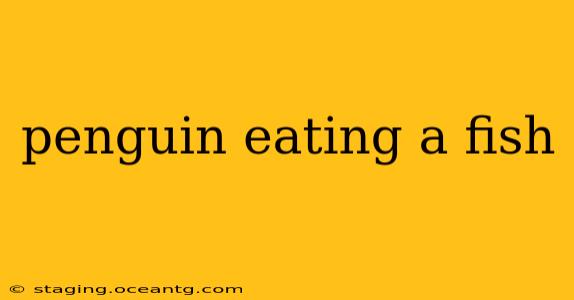The image of a penguin, sleek and upright, swallowing a wriggling fish is an iconic scene of the Antarctic. But there's more to this seemingly simple act than meets the eye. This post delves into the fascinating world of penguin feeding habits, exploring the types of fish they consume, their hunting techniques, and the vital role this plays in their survival.
What Kind of Fish Do Penguins Eat?
Penguins are carnivorous birds, and their diet consists primarily of various species of fish. The specific type of fish a penguin eats depends largely on its species and location. For example, emperor penguins, the largest penguin species, often feed on Antarctic silverfish, while smaller species like gentoo penguins might consume krill, squid, and smaller fish. Their diet is opportunistic; they'll eat whatever is most abundant and accessible in their environment. Common fish species found in penguin diets include:
- Antarctic silverfish: A staple food for many penguin species, these small, silvery fish are abundant in Antarctic waters.
- Myctophids (lanternfish): These deep-sea fish are a significant part of the diet of some penguin species, particularly those that dive to greater depths.
- Squid: Although not strictly fish, squid is a valuable protein source for many penguins.
How Do Penguins Catch Fish?
Penguins are remarkably adept hunters, using a variety of strategies to catch their prey. Their streamlined bodies and powerful flippers enable them to propel themselves through the water with remarkable speed and agility. They primarily hunt by pursuit, chasing fish underwater. Some species, like emperor penguins, can dive to impressive depths, exceeding 500 meters (1,640 feet) in search of food. Their exceptional eyesight and underwater vision allows them to spot fish from a distance.
What techniques do penguins use to catch fish?
Penguins employ several techniques to capture their prey:
- Pursuit: Chasing fish at speed until they are within striking distance.
- Ambush: Hiding amongst rocks or other underwater features to surprise their prey.
- Cooperative hunting: Some penguin species are known to cooperate in hunting, driving schools of fish together to make them easier to catch.
How Much Do Penguins Eat?
The amount of fish a penguin consumes varies depending on its species, age, and reproductive status. Generally, penguins need to eat a substantial amount of fish to maintain their body temperature in the frigid Antarctic environment and fuel their energy-intensive activities like swimming, breeding, and raising chicks. Adult penguins can consume several kilograms of fish per day, especially during the breeding season when they need to provide for their offspring.
What Happens If Penguins Don't Get Enough to Eat?
A lack of sufficient food can have devastating consequences for penguins. Malnutrition leads to reduced breeding success, weakened immune systems, making them more vulnerable to disease, and ultimately reduced survival rates. Changes in fish populations due to climate change or overfishing are a significant threat to penguin populations, highlighting the vital importance of a healthy ocean ecosystem.
What is the role of fish in the penguin ecosystem?
Fish are the keystone species in the Antarctic food web, and their abundance directly impacts the survival and thriving of penguin colonies. The health of penguin populations serves as an indicator of the overall health of the Antarctic ecosystem. Understanding their feeding habits and the challenges they face provides valuable insights into maintaining biodiversity and the balance of life in this delicate and crucial environment.
This detailed exploration hopefully answers many common questions about penguins' dietary habits and provides a more comprehensive understanding of this fascinating aspect of their lives. The simple act of a penguin eating a fish encapsulates a complex interplay of ecological factors crucial to the survival of both the bird and the environment it calls home.
